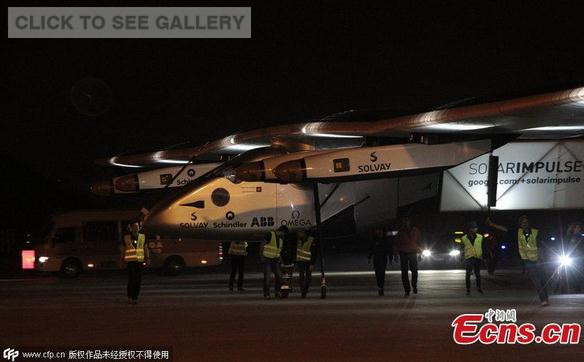About 1,600 young Chinese students stood, applauded and cheered as two Swiss pilots entered a school hall in Chongqing on Tuesday afternoon.
Early in the morning, pilot Bertrand Piccard had landed the Solar Impulse 2, the world's first solar-powered plane, at Chongqing Jiangbei International Airport after completing the fifth leg of an attempt to fly the Swiss-developed aircraft around the world powered only by the sun.
He is making the flight with fellow pilot Andre Borschberg.
The pair are taking turns to fly the single-seater aircraft - which is made from carbon fiber and has 17,248 solar cells built into its wing - 35,000 km over 12 legs, including across the Atlantic and Pacific oceans.
The journey back to Abu Dhabi, from where the journey began on March 9, is scheduled to take five months.
On Monday afternoon, Piccard took off for Chongqing from Mandalay, Myanmar's second-largest city. The plane flew for more than 20 hours, covering the 1,459 km above mountainous terrain in Yunnan and Sichuan provinces.
Piccard had to wear an oxygen mask and faced temperatures that fell to below-20 C. He also flew through strong low-level winds in Chongqing, making this leg one of the most challenging to date, according to both pilots.
The pilots and staff members from the Swiss embassy in China visited Chongqing Bashu Middle School to tell students about the journey and to raise awareness of clean energy.
Piccard told the audience, "Remember, this is an example, a symbol, an inspiration for you to do the same in your lives - to be pioneers. It can be for energy, for clean technology. It can also be in your way of thinking."
Borschberg, a former fighter pilot, told the students that he and his friend Piccard used to share a dream many years ago of building a plane as big as a Boeing 747, but as light as a car.
"If you have a dream, just go for it," he said. "Don't be afraid of failure. You will learn (from failure) and you will succeed in the end."
Jiang Chuhan, a ninth-grade student, asked the pilots how they acquired the pioneering spirit. "I have been so inspired by their bold exploits," she said. "We young Chinese students really need to be encouraged to be more innovative."
The plane is expected to remain in Chongqing for about 10 days due to weather conditions before being flown to Nanjing, Jiangsu province, and then across the Pacific Ocean to the United States.

















































